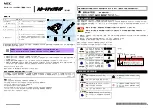
Scenario 2:1 - Flex-10 - VLAN Tagging (802.1Q) with Multiple Shared Uplink Sets (SUS) and Mapped VLANs - Windows
2003/2008 100
Scenario 2:1 - Flex-10 - VLAN Tagging (802.1Q)
with Multiple Shared Uplink Sets (SUS) and
Mapped VLANs - Windows 2003/2008
Overview
This scenario discusses the Flex-10 features provided in Virtual Connect. For an overview of Flex-10,
please refer to the following technology brief. HP Flex-10 technology brief:
http://h20000.www2.hp.com/bc/docs/support/SupportManual/c01608922/c01608922.pdf
Virtual Connect Flex-10 provides the ability to either present the 10Gb server NICs as single 10Gb NICs,
or divide each NIC into as many as 4 “physical function” NICs per NIC port. These physical function
NICs look to the server hardware and OS as physical NICs, have their own MAC address and can be
configured at speeds from 100Mb to 10Gb.
As shown in earlier scenarios, VLAN access can be handled in two different ways. Virtual Connect can
either pass VLAN/Non-VLAN traffic untouched to the host (Tunneling Mode) or Virtual Connect can
handle all VLAN tagging (Server Mapped VLANs). Each has their advantages as discussed in the
Introduction to Virtual Connect section, earlier in this document.
This scenario, using Map VLAN Tags, will focus more on the Virtual Connect Flex-10 technology. In this
scenario we have two10Gb uplinks configured with multiple VLANs. We will configure a Windows
2003 and Windows 2008 server initially with two 10Gb NICs. We will then show how Flex-10 can be
used to provide additional NICs to the server, without adding additional hardware. We will also show
how the speed of each NIC can be varied from speeds ranging between 100Mb to 10Gb.
Requirements
In order to implement this scenario, an HP BladeSystem c7000 enclosure with one of more Blade G6
servers with 10Gb NICs and TWO Virtual Connect Flex-10 Ethernet modules, installed in Bays 1& 2 are
required. In addition, we will require ONE or TWO external Network switches. As Virtual Connect does
not appear to the network as a switch and is transparent to the network, any standard managed switch
will work with Virtual Connect.















































